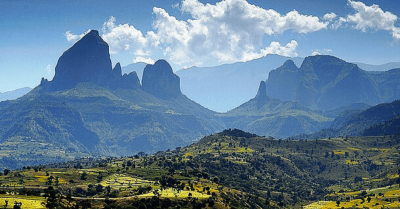
Located in the African country of Ethiopia, the Simien Mountains National Park covers an area of more than 135 sq.km. The region is a stunning landscape, a mosaic marked by undulating plateaus, sharp cliffs, and deep valleys. Part of a biodiversity hotspot that’s home to several globally threatened species, the Park was set up in 1969, especially to conserve these species. The region is also an Important Bird Area. The Park became a UNESCO World Heritage Site in 1978. However, the site was added to the List of World Heritage in Danger in 1996 due to the impact of a new road across it, excessive cattle grazing, agricultural encroachment and a drop in the Walia ibex Simien fox and other large mammal populations”. Inadequate infrastructure, encroachment, and destruction of habitat were concerns too. After this, slowly, things began to change. Finally, appreciative of Ethopia’s commitment to building another road and to the overall conservation of the region, UNESCO removed the Park from the Danger list in 2017.
Wildlife
As an Important Bird Area, the Park is said to nurture over 130 species of birds. Among these are ravens, eagles, buzzards, kites, falcons, hawks, kestrels, pigeons, doves, larks, starlings, wheatears, vultures, ibises, thrushes, kingfishers, francolins, pipits, parrots, ducks, geese, crakes, quails, herons, egrets, storks, bustards, thickknees, plovers. lapwings, gulls, terns, sandgrouses, cuckoos, coucals, owls, nightjars, swifts, beeeaters, barbets, woodpeckers, swallows, warblers, flycatchers, babblers, sunbirds, weavers, buntings, seedeaters, and sparrows. Among the most prominent endemic species in the region are the Walya ibex, Simien fox or Ethiopian wolf and gelada baboon, in addition to six species of birds. It is home to several other mammal species too. They include Anubis baboon, Hamadryas baboon, klipspringer, and golden jackal.
Threats
According to the International Union for Conservation of Nature, the conservation outlook for this site has been assessed as “significant concern in the latest assessment cycle (2020). The first natural site in Africa to be inscribed on the World Heritage list Simien National Park is located in the thickly populated Ethiopian highlands. And, that is the site’s greatest threat because these inhabitants are extensively dependent on the region’s natural resources for their existence. It is said that the number of people living around the Park has increased four times in just the last four decades. And this clearly impacts the wildlife in numerous ways. For one, some areas have come under cultivation, resulting in the loss of wildlife habitat. Further, a large portion has been used for intensive grazing by domestic livestock. Reports suggest that there are proposals to construct lodges inside the Park. This is contrary to the recommendations of UNESCO after it removed the Park from its Danger List. If these lodges are constructed, the presence of tourists would further affect the biodiversity of the region.
Some good news!
Despite all these, the population of many animals, including the highly endangered Walia ibex and Ethiopian wolf “as well as the endemic gelada, are reported to be stable thanks to the efforts of the park’s management and its partners. However, unless urgent and concrete steps are taken to preserve the wildlife, those populations may not continue to remain so.
Picture Credit : Google




